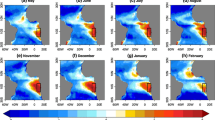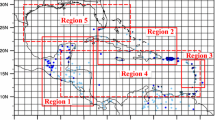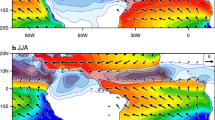Abstract
The study examines the perceived added value of downscaling atmosphere–ocean global climate model simulations over Africa and adjacent oceans by a nested regional climate model. NASA/Goddard Institute for Space Studies (GISS) coupled ModelE simulations for June–September 1998–2002 are used to form lateral boundary conditions for synchronous simulations by the GISS RM3 regional climate model. The ModelE computational grid spacing is 2° latitude by 2.5° longitude and the RM3 grid spacing is 0.44°. ModelE precipitation climatology for June–September 1998–2002 is shown to be a good proxy for 30-year means so results based on the 5-year sample are presumed to be generally representative. Comparison with observational evidence shows several discrepancies in ModelE configuration of the boreal summer inter-tropical convergence zone (ITCZ). One glaring shortcoming is that ModelE simulations do not advance the West African rain band northward during the summer to represent monsoon precipitation onset over the Sahel. Results for 1998–2002 show that onset simulation is an important added value produced by downscaling with RM3. ModelE Eastern South Atlantic Ocean computed sea-surface temperatures (SST) are some 4 K warmer than reanalysis, contributing to large positive biases in overlying surface air temperatures (Tsfc). ModelE Tsfc are also too warm over most of Africa. RM3 downscaling somewhat mitigates the magnitude of Tsfc biases over the African continent, it eliminates the ModelE double ITCZ over the Atlantic and it produces more realistic orographic precipitation maxima. Parallel ModelE and RM3 simulations with observed SST forcing (in place of the predicted ocean) lower Tsfc errors but have mixed impacts on circulation and precipitation biases. Downscaling improvements of the meridional movement of the rain band over West Africa and the configuration of orographic precipitation maxima are realized irrespective of the SST biases.














Similar content being viewed by others
References
Bolvin D, Adler R, Huffman G, Nelkin E, Poutiainen J (2009) Comparson of GPCP monthly and daily precipitation estimates with high-latitude gauge observations. J Appl Meteorol Clim 48:1843–1857
Burpee R (1972) The origin and structure of easterly waves in the lower troposphere of North Africa. J Atmos Sci 29:77–90
Del Genio A, Yao M-S (1993) Efficient cumulus parameterization for long-term climate studies. The GISS scheme. In: Emanuel K, Raymond D (eds) Cumulus parameterization, Amer. Meteorol. Soc. Monograph Series (Boston), vol 24, pp 181–184
Del Genio A, Yao M-S, Kovari W, Lo K-W (1996) A prognostic cloud water parameterization for global climate models. J Clim 9:270–304
Diaconescu E, Laprise R (2013) Can added value be expected in RCM-simulated large scales? Clim Dyn. doi:10.1007/s00382-012-1649-9
Diallo I, Sylla M, Giorgi F, Gaye A, Camara M (2012) Multi-model GCM-RCM ensemble-based projections of temperature and precipitation over West Africa for the early 21st century. Int J Geophys. doi:10.1155/2012/972896
Diallo J, Bain C, Gaye A, Moufouma-Okia W, Niang C, Dieng M, Graham R (2014) Simulation of the West African monsoon onset using the HadGEM3-RA regional climate model. Clim Dyn 43:575–594
Diedhiou A, Janicot S, Viltard A, de Felice P, Laurent H (1999) Easterly wave regimes and associated convection over West Africa and tropical Atlantic: results from NCEP/NCAR and ECMWF reanalyses. Clim Dyn 15:795–822
Druyan L (1998) The role of synoptic systems in the interannual variability of Sahel rainfall. Meteor Atm Phys 65:55–75
Druyan L, Fulakeza M (2013) Downscaling reanalysis over continental Africa with a regional model: NCEP versus ERA Interim forcing. Clim Res 56:181–196
Druyan L, Fulakeza M (2014) The impact of the Atlantic cold tongue on West African monsoon onset in regional model simulations for 1998-2002. Int J Climatol. doi:10.1002/joc.3980
Druyan L, Fulakeza M, Lonergan P (2006) Mesoscale analyses of West African summer climate: focus on wave disturbances. Clim Dyn 27:459–481
Druyan L, Fulakeza M, Lonergan P (2008) The impact of vertical resolution on regional model simulation of the West African summer monsoon. Int J Climatol 28:1293–1314
Druyan L, Feng J, Cook K, Xue Y, Fulakeza M, Hagos S, Konare A, Moufouma-Okia W, Rowell D, Vizy E (2010) The WAMME regional model intercomparison study. Clim Dyn 35:175–192
Hagos S, Cook K (2007) Dynamics of the West African monsoon jump. J Clim 20:5264–5284
Hsieh J-S, Cook K (2008) On the instability of the African easterly jet and the generation of African waves: reversals of the potential vorticity gradient. J Atm Sci 65:2130–2151
Huffman G, Bolvin D, Nelkin E, Wolff D, Adler R, Gu G, Hong Y, Bowman K, Stocker E (2007) The TRMM multisatellite precipitation analysis (TMPA): quasi-global, multiyear, combined-sensor precipitation estimates at fine scales. J Hydrometeor 8:38–55
Kim Y, Moorcroft P, Aleinov I, Puma M, Kiang N (2015) Variability of phenology and fluxes of water and carbon with observed and simulated soil moisture in the Ent Terrestrial Biosphere Model (Ent TBM version 1.0.1.0.0). Geosci Model Dev. doi:10.5194/gmdd-8-5809-2015
Miller R, Schmidt G, Nazarenko L et al (2014) CMIP5 historical simulations (1850-2012) with GISS ModelE2. J Adv Model Earth Sys 6:441–477. doi:10.1002/2013MS000266
Misra V, Kanamitsu M (2004) Anomaly nesting: a methodology to downscale seasonal climate simulations from AGCMs. J Clim 17:3249–3262
Oueslati B, Bellon G (2015) The double ITCZ bias in CMIP5 models: interaction between SST, large-scale circulation and precipitation. Clim Dyn 44:585–608
Rojas M, Seth A (2003) Simulation and sensitivity in a nested modeling system for South America. II. GCM boundary forcing. J Clim 16:2454–2471
Schmidt G, Ruedy R, Hansen J et al (2006) Present day atmospheric simulations using GISS ModelE: comparison to in situ, satellite and reanalysis data. J Clim 19:153–192
Schmidt G, Kelley M, Nazarenko L et al (2014) Configuration and assessment of the GISS ModelE2 contributions to the CMIP5 archive. J Adv Model Earth Syst 6:141–184
Sultan B, Janicot S (2000) Abrupt shift of the ITCZ over West Africa and intra-seasonal variability. Geophys Res Lett 27:3353–3356
Sultan B, Baron C, Dingkuhn M, Sarr B, Janicot S (2005) Agricultural impacts of large-scale variability of the West African monsoon. Agric For Meteorol 128:93–110
Acknowledgments
The research was performed with the support of NASA Cooperative Agreement NNX11AR63A. TRMM data were acquired using the GES-DISC Interactive Online Visualization and Analysis Infrastructure (Giovanni), part of NASA’s Goddard Earth Sciences (GES) Data and Information Services Center (DISC). GPCP data were obtained from NASA/GSFC/MAPL. ERA-I data were provided by the European Center for Medium Range Weather Forecasts, facilitated by the CORDEX project. NCEP/DOE reanalysis 2 data used in the study were obtained from the NOAA-ESRL Physical Sciences Division, Boulder CO online from www.esrl.noaa.gov/psd. The authors gratefully acknowledge the cooperation of GISS colleagues, Dr. K. Lo for accessing ModelE data and Dr. I. Aleinov for discussions about ModelE. Many constructive suggestions from two anonymous reviewers are also gratefully acknowledged.
Author information
Authors and Affiliations
Corresponding author
Additional information
This paper is a contribution to the special issue on West African climate decadal variability and its modeling, consisting of papers from the West African Monsoon Modeling and Evaluation (WAMME) and the African Multidisciplinary Monsoon Analyses (AMMA) projects, and coordinated by Yongkang Xue, Serge Janicot, and William Lau.
Rights and permissions
About this article
Cite this article
Druyan, L.M., Fulakeza, M. Downscaling GISS ModelE boreal summer climate over Africa. Clim Dyn 47, 3499–3515 (2016). https://doi.org/10.1007/s00382-015-2880-y
Received:
Accepted:
Published:
Issue Date:
DOI: https://doi.org/10.1007/s00382-015-2880-y




